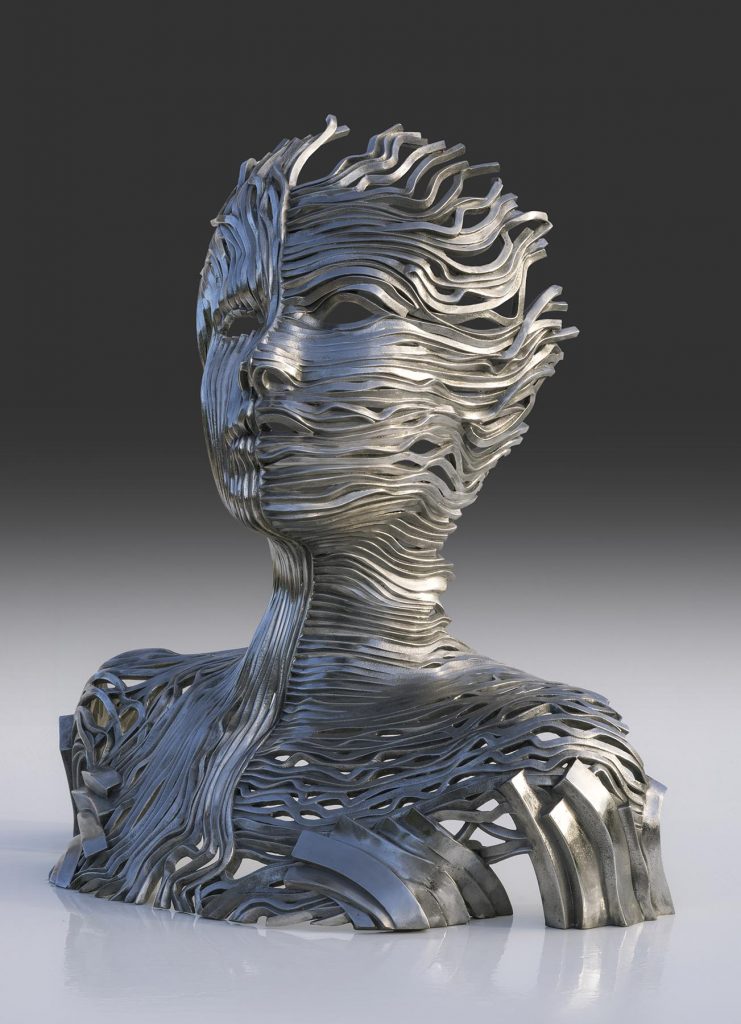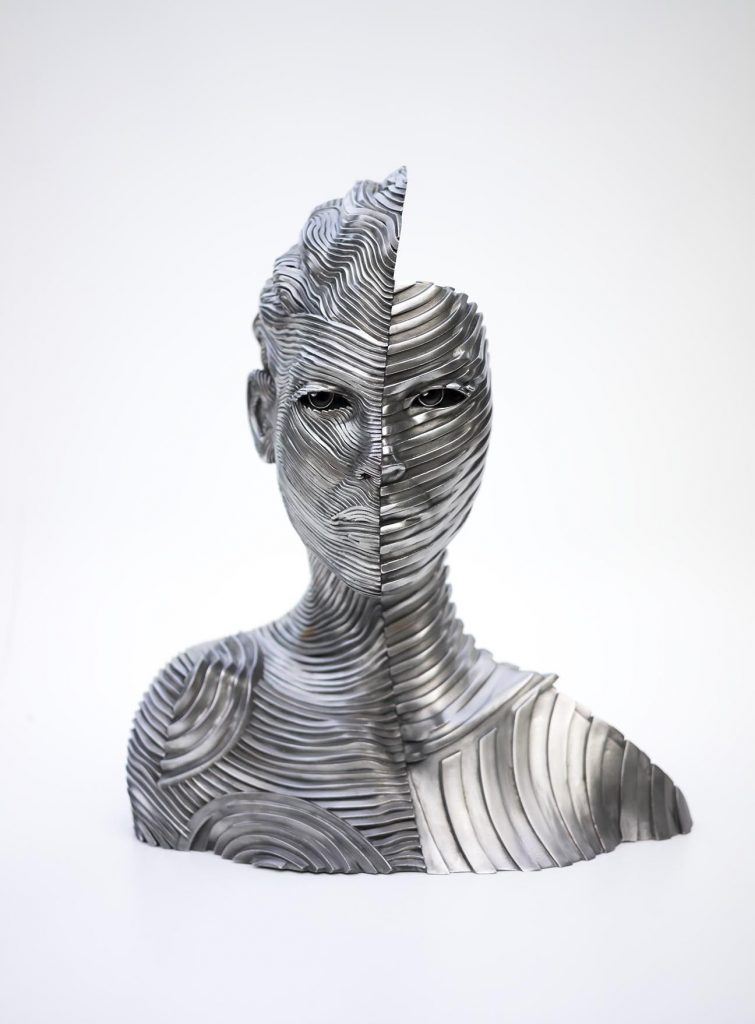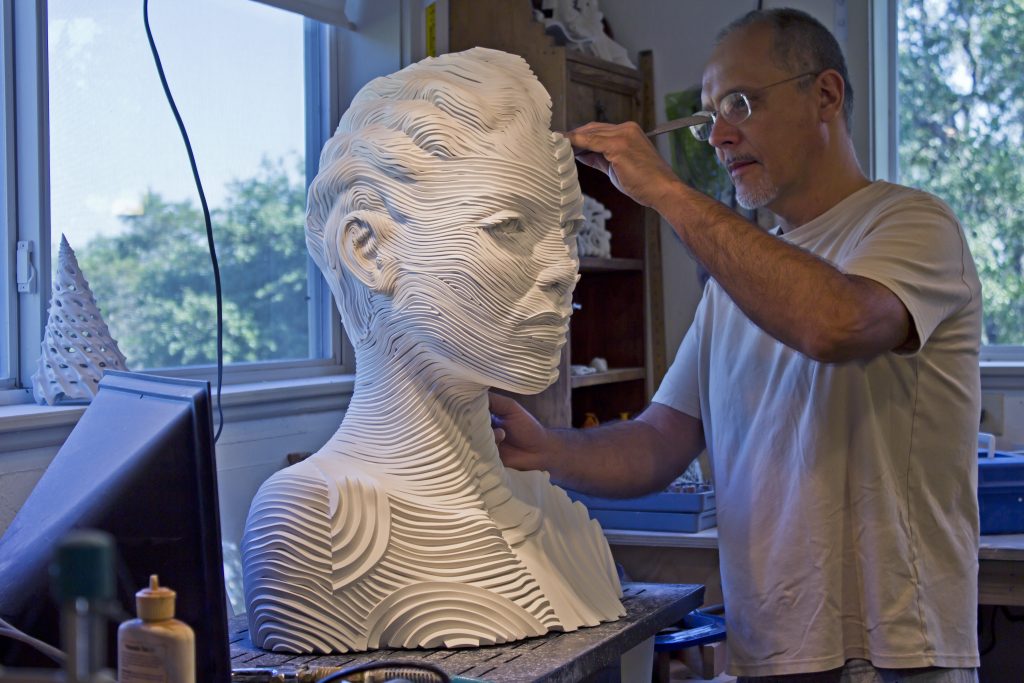Since he was nine years old, Gil Bruvel has known he wanted to be an artist and for the last four decades he has dedicated himself to that path. Working in painting, drawing, and sculpture, Bruvel is a true craftsman whose tremendous skill is clearly evident upon first glance.
The Steel Wire recently spoke with Bruvel about his Flow Series of sculptures. With ribbons of stainless steel, Bruvel has created stunning representations of life, its dualities, and its binding contradictions.
You’ve worked with a variety of media including oils, pencils, pastels, wood, and bronze. With the Flow Series you began using stainless steel. What inspired you to start working with steel?
Among all the different material I use for my artwork, stainless steel or inox steel has the qualities I needed to materialize the sculptures of the Flow Series. I wanted to create different variations of reflectivity for the surface of my artwork to fuse with its environment by simply reflecting it. The reflections can be made from grained surfaces up to a highly reflective mirror polish surfaces. If I want to represent the feeling of water or the sensation of the wind pressing on the skin like in the sculpture of the Wind, I can play with these variations to further the feeling of flow and my personal interpretations of patterns inspired by nature.
“Bringing stainless steel to this new platform was to bring the paradox of the sense of permanence that stainless-steel gives, its natural resistance to rusting over time and stability in harsh environment…”
– Gil Bruvel
Steel seems like it would be a difficult medium to work with. How has steel allowed you to express your creativity, compared to other media?
Stainless steel is indeed a rigorous material needing very structured methods to work with. But at the same time, it allows this illusory notion of opposite between the rigidity of steel and this sense of fluidity and movement I can infuse it with. It momentarily freezes the ephemeral, the constant motion of nature, permanence and impermanence.
It is impressive to see you create such elaborate pieces using steel. Can you describe your work process? How do you go from idea to steel sculpture? How long does it take? What tools do you use to mold your sculptures?
I start with various sketches and a considerable amount of time figuring out what my intentions are about a specific piece. This represents multiple iterations with sketches whether it is inspired by, as examples, erosions carved by the wind or water, dunes formations, ripples in the sand, physical sensations, motions, emotions, the grass or leaves in trees pushed by the wind and the infinite myriads of patterns small or large nature is made of.
Then I start to model the concepts until I think it is ready to receive a silicon mold. With this mold, we pull a wax for the lost wax process at the foundry and to finally do the casting. After removing the sprues and chasing the surface of the steel, I start to play with the reflectivity of the surface up to the most polished parts of the final sculpture.
It takes many months to create a sculpture from the original concept to the final cast.

Gil Bruvel’s Dichotomy sculpture that “meditates on and celebrates the dual nature of existence.” (Photo courtesy of Gil Bruvel)
Which steel sculpture would you consider to be your best, or favorite? And why?
My favorite sculpture of the Flow Series is of course the next one I am about to do with the renewed excitement to apply the new skills and knowledge I gathered from the previous works with the integration of new ideas and concepts as well as continuing to explore and studying new patterns.
“Among all the different material I use for my artwork, stainless steel or inox steel has the qualities I needed to materialize the sculptures… -Gil Bruvel
I like the sculpture of Dichotomy for the simplicity of its message about the human condition. The vertical lines in opposition with the horizontal lines contained within this same bust, whatever contradictions or oppositions we experience are simply part of who we are.
The sculpture of Rain is also one of my favorite for its meditative aspect. The sculpture entitled River with its metaphor of the river flow carrying our memories and experiences.
The Wind, the euphoric awareness of being alive, feeling the wind against our skin. And many other sculptures.

Offering a variation on the theme of human frailty, My Mirror Remains explores what it means to be fully human. (Photo courtesy of Gil Bruvel)
What message are you ultimately trying to convey through the Flow Series? How does using steel help you communicate that?
All the above might contribute to this question, but mainly I see art as a platform, an opportunity to experiment with my own perspective, in the form of artwork to show and share the results of these experimentations. To keep building a universal language we can all relate to. I think the universality of steel lends itself to this idea. Our planet is shrinking with the way we communicate and art can be what binds us together.
How is your artistic vision embodied through your use of steel in the Flow Series? How is it connected (or different) from your other work?
The many different material and methods I use to create my artwork goes in parallel with my passionate pursuit of knowledge. The Flow Series has been a centerpiece to my creative process, and I see it as a continuum to my previous experiments with other materials. Bringing stainless steel to this new platform was to bring the paradox of the sense of permanence that stainless-steel gives, its natural resistance to rusting over time and stability in harsh environment comparatively to other material; and at the opposite, the artistic expression of fleeting moments and ephemeral nature of our experiences we have, the constant changes and impermanence of life.
The Steel Wire is excited to have had the opportunity to talk with Gil Bruvel. His artistry and expertise surpass expectations and his exquisite sculptures show us the beauty that can be found in steel.
Watch the video below to see some of Gil Bruvel’s favorite pieces and hear more about his work process and inspiration. You can find out more about the artist and his exhibitions by visiting his website or following him on Facebook, Instagram, or Twitter.
BRUVEL from One Story Productions on Vimeo.

